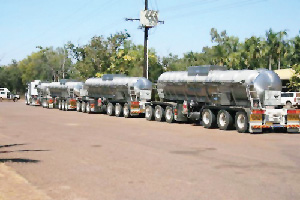
The Week’s Weather up to Friday 03 February Five-day outlook to Wednesday 08 February

Precipitation forecast from Friday 03 February to Saturday 11 February 2017. Source: wxmaps.org, GrADS/COLA
The South Atlantic high pressure cell remains offshore. The core, measuring a moderate 1024 mB is more than 2000 km away from the continent. It has been in this vicinity since November last year. The only noticeable shift has been southward, first by some 600 km from the Walvis Bay latitude to the Port Nolloth latitude. During January, it made a further transition to the south, with its core now straddling the 40°S latitude. Longitude-wise, it has remained on the same meridian at about 20°W.
Thus, although displayed towards the north during the early part of the summer, it has now moved south of its customary latitude by some 600 km.
When the South Atlantic high seems to be stuck offshore, only its outer rim at 1016mB has a direct impact on Namibian weather, but it is still a significant impact as this high is a mighty beast, even in summer.
Its leading edge blows wind from south to north along the Namibian coastline. Usually these winds will follow the curve, morphing into the trade winds that blow in the Inter-Tropical Convergence Zone, the so-called ITCZ. Not so during the past two weeks.
The south to north windflow has hugged the coastline from Cape Town to the Mocamides in Angola. From there, instead of crossing the ocean, they have recurved over the continent, clearing central and western Angola of moisture, leading to reduced precipitation in the western half of Angola. But this surface intrusion of the high has had another effect, the result of which we saw this week.
As the high crosses Angola from west to east, it encounters the normal zonal airflow from east to west, the so-called Indian Ocean transport, which is the channel for moisture from the Indian Ocean into central and southern Africa.
Where these two airflow meet in the lower levels, a prominent cyclonic circulation ensues, leading to a well-defined low pressure system. Such a system was present over northern Botswana early in January with a similar system developing over northern Namibia and southern Angola as the week progressed.
The strength of this low pressure system was evident even up to the 500 mB surface at some 18,000 feet where a sequence of ridges and troughs was situated over southern Angola, with the mid-level trough pushing deep into Namibia, all the way to the eastern section of the Hardap Region along the Botswana border.
While this was developing, the ITCZ over Madagascar, the Mozambican Channel, Mozambique, Zambia and Zimbabwe was well-defined bringing in large amounts of moisture from the Indian Ocean, transporting it across the southern African sub-continent and linking up with the cyclonic circulation over southern Angola.
The result was a continuous band of precipitation stretching from central Angola and Western Zambia into Namibia and Botswana, and from there furhter south into the South African interior.
Meanwhile, on the eastern side of the continent, the southern Indian high pressure cell has shifted even further south than its South Atlantic twin. Its core is now situated some 3000 km south-east of Madagascar with a weaker, secondary core offshore Kwazulu-Natal.
What’s Coming
The southward displacement of the cores of both the South Atlantic and the southern Indian high pressure cells creates space over southern Africa for tropical low pressure conditions to move south.
This is indeed what is happening and for the next five days, moisture intrusion will continues from Zambia and Angola into central Namibia, Botswans and South Africa.
The outer rim of the South Atlantic high continues to dominate conditions over the Northern Cape, the western half of Namibia and western and central Angola.
A prominent convergence zone is active over Namibia with the rainfall bias confined to the north-eastern quadrant. However, moisture penetration continues from the north-east, and isolated showers can occurs anywhere in Namibia west of the escarpment.
By Monday, the tropical systems starts gaining the upper hand as the high’s leading edge departs to the east.
Rainfall prospects remain positive for Monday, Tuesday and Wednesday but only over the interior west of the escarpment. The ITCZ remains strong, meaning rainfall in the Caprivi, Bwabwata and both Kavangos can be severe.
A low pressure system just offshore east of Madagscar has the potential to develop into a vortex from Monday onwards. If this turns out to be, rainfall over Namibia for the whole week will be higher than the current forecasts.











































